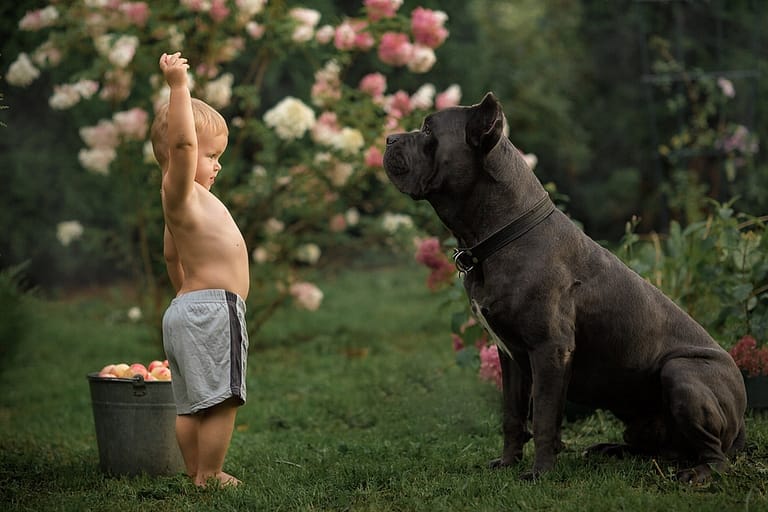Cane Corso Vs Pitbull
Pitbull and Cane Corso are bright, devoted, and easy to care for, just to name a few qualities that truly distinguish them. You’ll never get bored having A Cane Corso or a Pitbull around your home because they make the ideal snuggle friends. They are both stunning dogs that make wonderful family companions; they simply need to be placed with the proper household.
But if you’re having trouble deciding which of these two dog breeds is best for you, you’ve come to the perfect place.
We will compare a Pit Bull and a Cane Corso and highlight the differences in their size, temperament, and trainability.
So, let’s take a closer look at the similarities and differences between the two breeds to determine which breed will work best for you and your family.
- Pit Bull Vs Cane Corso: Breed History
- Pit Bull Vs Cane Corso: Size And Appearance
- Pit Bull Vs Cane Corso: Temperament
- Pit Bull Vs Cane Corso: Bite Strength Compared
- Pit Bull Vs Cane Corso: Training
- Pit Bull Vs Cane Corso: Health & Care
- Cane Corso Vs. Pitbull: Cost
- Pit Bulls Are Best For?
- Cane Corso Are Best For?
Pit Bull Vs Cane Corso: Breed History
Both breeds are members of the Molosser dog family, but before we can infer anything about how they will behave as a family pets, it’s critical to comprehend the history of each dog.
You can probably find one without going to a breeder because both breeds have somewhat distorted pasts that make them popular rescue/shelter pets.
What Are Mollosser Dogs?
The word “Molosser” is derived from the Molossi, a tribe of ancient Greeks from the region of Epirus, which was historically a part of northwest Greece.
It is said that the Molossi are responsible for breeding big, powerful guard dogs. These powerful dogs were guard dogs and were used in battle. They were renowned for their fierceness, bravery, and extreme loyalty.
It is believed that the Molossi owned two different breeds of dogs. One had a dark hue for nighttime camouflage and was mostly used for guarding property. The second variety had a lighter tint to better blend in with the flocks and herds they guarded.
The Molosser dogs of today are renowned for:
Massive, well-muscled bodies with wide, deep chests.
Protective natures and fierce loyalty.
Courageousness in fending off much larger opponents.
Relatively short muzzles and large, broad heads.
Pitbull History
Pit Bulls were bred from Old English Bulldogs in the early nineteenth century in the United Kingdom. They were often used for bear and bull baiting until the practice was outlawed, at which point many owners regrettably switched to rat-baiting, a dreadful pastime conducted in a pit, hence the dog’s name.
The dogs were soon being brought to the US by settlers, who adored them for their protective traits. There isn’t, however, a single breed of Pit Bull. The name is used to refer to the American Staffordshire Terrier, American Pit Bull Terrier, Staffordshire Terrier, American Bully, and, in certain cases, the American Bulldog in the United States.
Cane Corso History
The Cane Corso, often known as the Italian Mastiff, originated from the enormous Roman military dogs and is phonetically pronounced as “Kay-Nah Kor-So.” Initially used as a farm dog, he went on to work in a variety of capacities, including sheep herding, cattle droving, cart pulling, and estate guarding.
The Neapolitan Mastiff, which was utilized in the restoration program, had a significant influence on the breed that we know and love today. The Cane Corso breed was on the verge of extinction, but thanks to breeding enthusiasts, his numbers were quickly restored.
In 1988, the first litter of Cane Corsos arrived in the United States. Since then, he has established himself as a beloved family pet and friend.
Pit Bull Vs Cane Corso: Size And Appearance
Both are strong dogs with square heads and strong jaws, but there are several distinctions, with size being the most significant. The Cane Corso is considered a large breed due to its typical height of 28 inches (71 cm). While pit bulls are medium-sized dogs, their height ranges from 13 to 24 inches (35 to 60 centimeters), making them notably shorter.
The weights differ significantly as well. The average adult weight of a Cane Corso is between 85 and 100 pounds (38 and 45 kilograms), while a Pit Bull rarely exceeds 80 pounds (36 kilograms)
A Cane Corso has a larger and wider muzzle than a Pit Bull, as well as a wrinkled face and looser-looking skin behind a dense and thick short coat. Pit Bulls, in comparison, have short, smooth-looking coats over considerably tighter skin, unwrinkled cheeks, and smaller ears on top. Their eyes range in shape from round to almond-shaped.
Pit Bull Vs Cane Corso: Temperament
Both breeds must be socialized from a young age to mitigate some of their innate characteristics.
You can anticipate a lot of fun and games with both the APBT and the Cane Corso because both breeds are funny and lively with their immediate family. They both adore and fiercely guard their human siblings, and you can frequently find them on the couch snuggled up to the lesser members of the pack. Due to their size, they should both be closely watched around kids and other animals to prevent an unintentional accidents.
They both tend to have separation anxiety due to their sociability, so it’s crucial to provide them with brain games or emotionally satisfying puzzle games to keep their minds engaged while you’re gone.
Both of them are extremely obedient canines who want nothing more than to please their owner. As a result, they can both be easily trained. Friends can feel at ease when they call on your door because the APBT is quite friendly with almost everyone, whether they are friends or strangers.
The Cane Corso, on the other hand, is a considerably more dominating dog, thus he requires a master who is willing to take on the challenge of being much more dominant than he is. It is necessary to house the Cane Corso with a family.
The Cane Corso is extremely wary of strangers and won’t let anyone approach his family unless specifically told to. He is constantly watchful and never completely lowers his guard. On the other hand, when instructed, he will be hospitable and welcoming of strangers. Therefore, among these two breeds, the Cane Corso is the perfect choice if you’re looking for a guard dog.
Pit Bull Vs Cane Corso: Bite Strength Compared
Bite strength, also known as bite force, is the term used to describe how much force an animal’s jaws are capable of exerting. It is typically expressed in pounds per square inch or psi.
The bite force of a Cane Corso is estimated to be 700 psi, more than double that of a Rottweiler. A Pit Bull, on the other hand, usually reaches its peak pressure at roughly 235 psi.
To put your mind at ease, canine attacks on people are uncommon, and the majority occur in self-defense, such as when a dog is mistreated or observes an attack on his owner. And keep in mind that unless a dog is fighting for his or his owner’s life, he usually is unlikely to use his maximum bite force.
Pit Bull Vs Cane Corso: Training
The Cane Corso is a smart dog that is simple to train. Compared to other breeds that performed comparable jobs, it is not as independent. Positive reinforcement, however, is crucial.
For such a large and powerful dog, it is surprisingly sensitive. The good news is that this breed lacks either nip or a strong wanderlust. It does, however, have a strong prey drive.
The American Pit Bull Terrier is intelligent, which makes it simple to train. Naturally, treats make it a whole lot simpler. It tends to bark intermittently. It can, however, be a feisty puppy, which you’ll need to tame from the start. We strongly advise you to use positive reinforcement because it is sensitive to harsh words or scolding.
Pit Bull Vs Cane Corso: Health & Care
The American Pit Bull is another healthy breed with minimal concerns other than those expected of a dog of its size. You should also keep hypothyroidism and heart disease on your radar due to their increased proclivity for these ailments. These dogs’ ears should be cropped, and the tail should be docked, per AVMA guidelines.
Fortunately, Cane Corsos have minimal health problems besides elbow and hip dysplasia, which you would expect in a huge dog. However, trustworthy breeders will perform pre-breeding health examinations to stop it from transferring to their dogs’ pups. Bloat is another risk for the Cane Corso, which is typical for dogs with large chests like this one.
Cane Corso Vs. Pitbull: Cost
Depending on the breeder, your region, and the sex of your puppy, a Cane Corso puppy will typically cost between $1,000 and $2,500. You should budget between $3,000 and $5,000 for superior lines. An American Pitbull Terrier typically costs $1,100, but you may need to pay up between $3,500 and $10,000 for a dog with championship bloodlines or a rare breed, like a blue or bluenose Pitbull.
The greatest advice is to stay away from breeders who label any dog they sell as “rare.” Although reputable breeders may charge more for some animals, they will never exploit the phrase or use it as a sales tactic.
When you buy your puppy, keep in mind that a lot of time, money, and work went into developing it. Each litter is produced for between $3,000 and $5,000 (perhaps more) by a qualified breeder. And that excludes any additional overheads.
So, if you get a regular, pet-quality dog, there isn’t much of a difference between the Cane Corso and the Pitbull. If you choose a dog with championship bloodlines or one of the rarer colors, the costs for both will skyrocket.
Pit Bulls Are Best For?
This breed is best suited for households with older children. The American Pit Bull Terrier is the exact opposite of what people might think a dog with that name would be like. This dog is not aggressive at all. However, the stigma continues to exist.
Unfortunately, some individuals are missing out on the love and happiness that this dog may bring into their lives. This breed needs a pet owner who can give it the time and care it needs for training.
Cane Corso Are Best For?
It is great for people who have the time to devote to training their dogs. The Cane Corso is a powerful and active dog. And it’s energizing. These factors indicate that prior pet ownership is necessary to appropriately raise this puppy.
It’s an attractive animal without question, and it might draw a lot of potential dog owners. However, it also serves as an illustration of the significance of doing breed study before bringing a puppy home.

Hey, I’m Caroline, and I’m all about bulldog love, travel, and lending a helping hand to shelter pals. Writing about dogs for five years has let me share the magic of their stories and the world of pet care. My heart? It belongs to Bella, my amazing bulldog sidekick. Together, we’re off on adventures, spreading kindness, and making shelter life brighter. Join us in celebrating the joy of dogs and making a difference!






